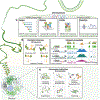Decrypting the complexity of the human malaria parasite biology through systems biology approaches
- PMID: 37200864
- PMCID: PMC10191146
- DOI: 10.3389/fsysb.2022.940321
Decrypting the complexity of the human malaria parasite biology through systems biology approaches
Abstract
The human malaria parasite, Plasmodium falciparum, is a unicellular protozoan responsible for over half a million deaths annually. With a complex life cycle alternating between human and invertebrate hosts, this apicomplexan is notoriously adept at evading host immune responses and developing resistance to all clinically administered treatments. Advances in omics-based technologies, increased sensitivity of sequencing platforms and enhanced CRISPR based gene editing tools, have given researchers access to more in-depth and untapped information about this enigmatic micro-organism, a feat thought to be infeasible in the past decade. Here we discuss some of the most important scientific achievements made over the past few years with a focus on novel technologies and platforms that set the stage for subsequent discoveries. We also describe some of the systems-based methods applied to uncover gaps of knowledge left through single-omics applications with the hope that we will soon be able to overcome the spread of this life-threatening disease.
Keywords: Multiomic analysis; Omics; Plasmodium; malaria; systems biology.
Conflict of interest statement
Conflict of interest The authors declare that the research was conducted in the absence of any commercial or financial relationships that could be construed as a potential conflict of interest.
Figures




References
-
- Ay F, Bunnik EM, Varoquaux N, Bol SM, Prudhomme J, Vert JP, et al. (2014). Three-dimensional modeling of the P. falciparum genome during the erythrocytic cycle reveals a strong connection between genome architecture and gene expression. Genome Res. 24 (6), 974–988. doi:10.1101/gr.169417.113 - DOI - PMC - PubMed
-
- Ay F, Bunnik EM, Varoquaux N, Vert JP, Noble WS, and Le Roch KG (2015). Multiple dimensions of epigenetic gene regulation in the malaria parasite Plasmodium falciparum: Gene regulation via histone modifications, nucleosome positioning and nuclear architecture in P. falciparum. Bioessays 37 (2), 182–194. doi:10.1002/bies.201400145 - DOI - PMC - PubMed
Grants and funding
LinkOut - more resources
Full Text Sources
Miscellaneous
